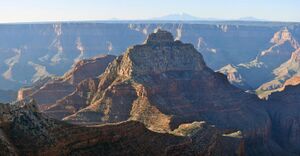Earth:Vishnu Temple (Grand Canyon)
| Vishnu Temple | |
|---|---|
 North aspect, from Angels Window Overlook | |
| Highest point | |
| Elevation | 7,533 ft (2,296 m) [1] |
| Prominence | 1,813 ft (553 m) [1] |
| Parent peak | Wotans Throne (7,740 ft)[2] |
| Isolation | 1.77 mi (2.85 km) [2] |
| Coordinates | [ ⚑ ] : 36°05′20″N 111°56′09″W / 36.0887641°N 111.9357062°W [3] |
| Geography | |
Lua error in Module:Location_map at line 522: Unable to find the specified location map definition: "Module:Location map/data/Arizona" does not exist.
| |
| Location | Grand Canyon Coconino County, Arizona, US |
| Parent range | Kaibab Plateau[1] Colorado Plateau |
| Topo map | USGS Cape Royal |
| Geology | |
| Type of rock | Coconino Sandstone |
| Climbing | |
| First ascent | 1945 |
| Easiest route | class 4 climbing[2] |
Vishnu Temple is a 7,533-foot-elevation (2,296-meter) summit located in the Grand Canyon, in Coconino County of Arizona, US.[3]
Description
Vishnu Temple is situated two miles south-southeast of the Cape Royal overlook on the canyon's North Rim, 1.5 mile south of Freya Castle, and two miles east-southeast of Wotans Throne, its nearest higher neighbor. It towers 4,900 feet (1,500 meters) above the Colorado River. According to the Köppen climate classification system, Vishnu Temple is located in a cold semi-arid climate zone.[4] According to explorer Frederick Samuel Dellenbaugh, Vishnu Temple is "without doubt the most stupendous mass of nature's carving in the known world."[5]
History
Vishnu Temple is named for Vishnu, the Hindu deity, redeemer of the universe. This toponym was applied in 1880 by Clarence Dutton who thought this mountain resembled an oriental pagoda, when he began the tradition of naming geographical features in the Grand Canyon after mythological deities.[6][7] This geographical feature's toponym was officially adopted in 1906 by the U.S. Board on Geographic Names.[3] The first ascent of the summit was made by Merrel Clubb and his son on July 13, 1945.[8]
Geology
The summit of Vishnu Temple is composed of cream-colored, cliff-forming, Permian Coconino Sandstone with a Kaibab Limestone cupola caprock.[9] The sandstone, which is the third-youngest of the strata in the Grand Canyon, was deposited 265 million years ago as sand dunes. Below the Coconino Sandstone is slope-forming, Permian Hermit Formation, which in turn overlays the Pennsylvanian-Permian Supai Group. Further down are strata of Mississippian Redwall Limestone, Cambrian Tonto Group, and finally Proterozoic Unkar Group at creek level.[10] Precipitation runoff from Vishnu Temple drains south into the Colorado River via Vishnu Creek on its west side, and Unkar Creek on the east side.
Gallery
See also
- Geology of the Grand Canyon area
- Rama Shrine
References
- ↑ 1.0 1.1 1.2 "Vishnu Temple, Arizona". http://www.peakbagger.com/peak.aspx?pid=17268.
- ↑ 2.0 2.1 2.2 "Vishnu Temple – 7,533' AZ". https://listsofjohn.com/peak/71700.
- ↑ 3.0 3.1 3.2 "Vishnu Temple". United States Geological Survey. https://geonames.usgs.gov/apex/f?p=gnispq:3:::NO::P3_FID:13240.
- ↑ Peel, M. C.; Finlayson, B. L.; McMahon, T. A. (2007). "Updated world map of the Köppen−Geiger climate classification". Hydrol. Earth Syst. Sci. 11. ISSN 1027-5606.
- ↑ Byrd H. Granger, Grand Canyon Place Names, 1960, University of Arizona Press Tucson, p. 25.
- ↑ Dutton, Clarence E. (1882). The Tertiary History of the Grand Cañon District. Washington, DC: Government Printing Office. p. 148. https://babel.hathitrust.org/cgi/pt?id=uc1.31822043037282&view=1up&seq=230. From p. 148: "The finest butte of the chasm is situated near the upper end of the Kaibab division; but it is not visible from Point Sublime. It is more than 5,000 feet high, and has a surprising resemblance to an Oriental pagoda. We named it Vishnu's temple."
- ↑ Randy Moore and Kara Felicia Witt, The Grand Canyon: An Encyclopedia of Geography, History, and Culture, 2018, ABC-CLIO Publisher, p. 151.
- ↑ John Annerino, 'Hiking the Grand Canyon", 2017, Simon & Schuster, ISBN:9781510714984
- ↑ N.H. Darton, Story of the Grand Canyon of Arizona, 1917, p. 58.
- ↑ William Kenneth Hamblin, Anatomy of the Grand Canyon: Panoramas of the Canyon's Geology, 2008, Grand Canyon Association Publisher, ISBN:9781934656013.
External links
- Weather forecast: National Weather Service
- Weather: Vishnu Temple
- Vishnu Temple aerial video: National Park Service
 |












